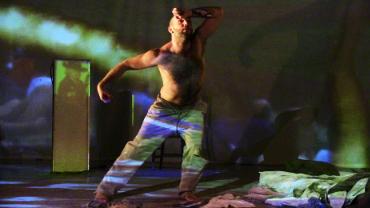Canadian choreographer Gerry Trentham has turned crossing borders into an art form. The veteran artist has presented his inventive works extensively on both sides of the 49th parallel, as well as in Australia and East Asia. While the constant travel inherent in an international career is old hand for the Dancemakers alumnus, his new project, Four Mad Humours, takes crossing borders to a whole new level.
The series of four solos will be presented in simultaneous pairs in different cities, first in Toronto and Buffalo, then later in Chicago and Montreal. Each performance will feature a live video feed of the concurrent piece in the opposing city, giving audiences in both places a chance to see the pieces at the same time. But the work is not just a means of showing off fancy technology. It’s also about examining its real-world effects.
“We have the opportunity to live in a virtual world, which means all sorts of incredible possibilities for learning and communication,” Trentham says. “Technology can move us forward in certain ways and allow us to become more whole with each other. I wanted to see how the technology that connects us intellectually and politically could reconnect us with our physical selves.”
While the form of the piece is decidedly 21st century, its subject matter is more archaic. Each solo is based on one of the four humours of the body (choleric, phlegmatic, sanguine and melancholic), a philosophical system used as the basis for Western medicine from Greco-Roman times till the 1800s. Diseases and emotional states were often attributed to an excess of one of the humours, and treated accordingly.
“I knew how I wanted to work with the technology and that it was going to be four dancers, but I needed a concept to join those things together,” he says. “I’ve been fascinated with the humours for a long time and I often use them as a conceptual framework in my teaching. We were working with contemporary technology, so it seemed like an interesting contrast to view the body through an ancient lens.”
Incorporating vividly coloured sets and costumes (each humour is associated with a specific shade), each piece sees the character transition from an excess of one humour toward a more balanced state of being. Trentham’s own solo, “Choleric” (the humour of anger), is based on his childhood in Drumheller, Alberta. Dubbed the dinosaur capital of Canada for its abundance of prehistoric fossils, the dusty burg was a hard place to grow up for a sensitive kid with a passion for knitting.
“It was a really rough town and people were always trying to toughen you up and make you more masculine,” he says. “All that ridicule made me a pretty violent kid. My solo tells the story of a boy becoming a man, moving from an overabundance of anger at the beginning towards a more balanced way of being.”
Trentham and media designer Jamie O’Neil first tossed around the idea for the project five years ago. Internet technologies like Skype were popping up, granting virtual presence practically anywhere in the world, for the first time ever. Curious about how live performance might translate across wires, the pair did a lengthy series of experiments to explore the technology’s artistic possibilities. While the creative results have been fruitful, managing the technology has been no small feat.
“Some people dream up a crazy idea, wake up, and say, ‘That was a nice dream.’ I wake up and say, ‘Let’s do it!’” Trentham laughs. “It’s been a complicated process at times, but challenging these kinds of artistic boundaries is what has kept me going for so long.”


 Why you can trust Xtra
Why you can trust Xtra


